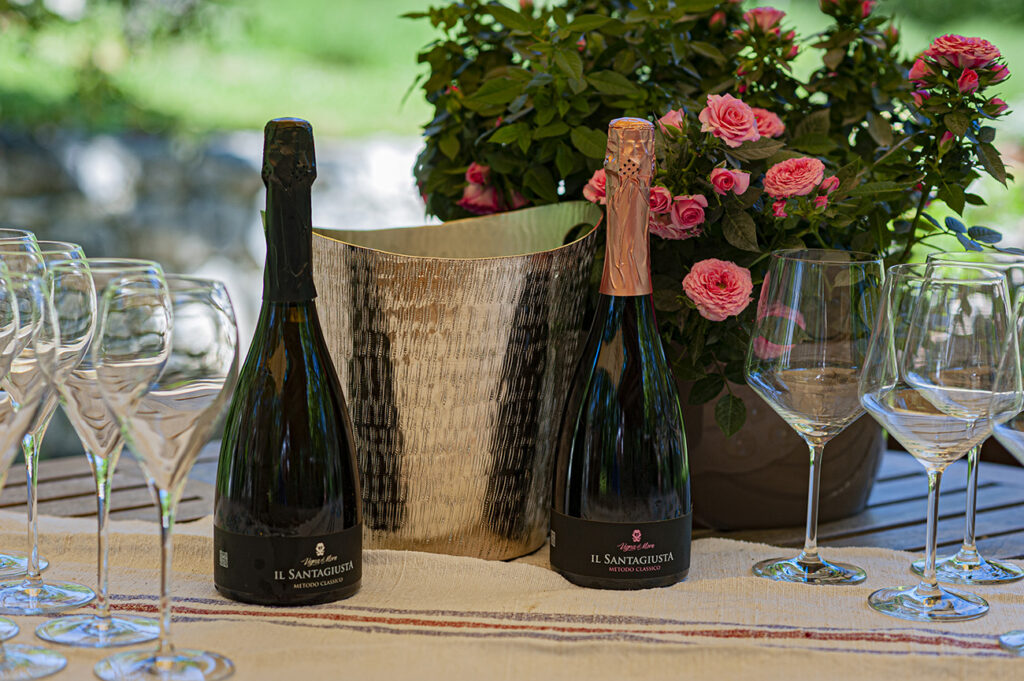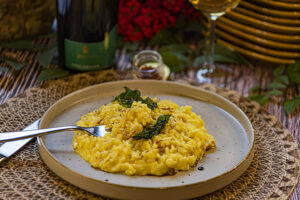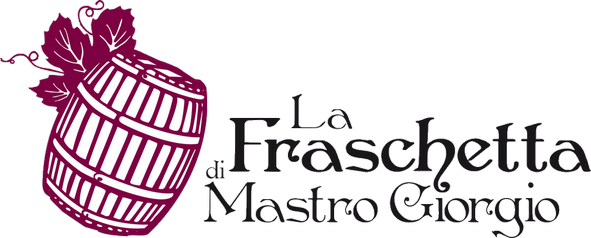Abruzzo
The Italian culture of the tableDinner and Tasting
Dinner and Tasting
Thursday 30 March, 8.30 pm
very limited seats
Mastro Giorgio’s Fraschetta, Via Alessandro Volta 36, Testaccio (Rome)
Telling us about Tuscan recipes: Chef Umberto Daeder
Telling us about the wine: Adriana Tronca from the Vigna di More Winery< /strong>(Goriano Valli, AQ)
With the participation of Stefano Di Fiore of Bontà Di Fiore

To enrich the dinner, the products of :
Bontà Di Fiore / Scuppoz / Table of the Brigands / Vineyard of More
The menu:
STARTER:
Crispy Cacio e Ova Pallotte on Avezzano Red Potato Cream, Sweet Altino Chili Pepper Slow Food Presidium Table of Brigands
Accompanied by homemade focaccia with flour with wheat germ and sourdough, “Sciapo” bread and hand-rolled artisanal breadsticks.
In combination with Metodo Classico “Il Santagiusta” 2014 (Pinot Noir and Chardonnay)
*****
FIRST:

Organic Carnaroli risotto with Kerner Terre Aquilane and Vigna di More saffron
In combination with Terre Aquilane Bianco 2021
*****
Artisan Egg Fregnacce with Ventricina Vastese Ragout Slow Food Bontà Di Fiore Presidium
In combination with Terre Aquilane Pinot Noir Lamata 2019
*****
SECOND:
Neretese-style kid with Sweet Altino Chili Pepper “Tavola dei Briganti” Slow Food Presidium and crunchy polenta< /em>
In combination with Terre Aquilane Pinot Noir Lamata 2019
*****
TO CONCLUDE:
served with a pleasant surprise from Adriana Tronca and Vigna di More
Sheep gentian Scuppoz
Booking no later than Tuesday 28-03-2023 upon payment of a deposit of € 10 per guest to:
La Fraschetta Srl
IBAN: IT42I 03440 03218 000 000 175 100
Bic/Swift BDBDIT22
Reason: tasting 30.03.23 for … people
Once the transfer has been made, it will be advisable to report it to the contacts below.
06 574 1369
info@lafraschettadimastrogiorgio.com
Testaccio (Rome), Via Alessandro Volta 36
To know more…
Neretese kid
(from Granconsigliodellaforchetta and Wikipedia)
The capra alla neretese is a typical recipe of Abruzzo, in particular of Nereto and some neighboring municipalities such as Torano Nuovo, Corropoli, Controguerra, Sant’Omero, Ancarano and Colonnella, all in the province of Teramo. This kid meat dish is traditionally prepared during the Easter holidays, in which the kid meat is flavored with delicious red peppers.
Pallotte Cheese and Ova
Pallotte with cheese and eggs are one of the classic dishes of the Abruzzo peasant tradition, (“pallott cace e ove” in the local dialect).
These are delicious meatballs (pallotte, to be precise) made with cheese and eggs.
The peculiarity that makes them really greedy, in reality, is that these meatballs are first fried and then sautéed to flavor themselves in a tomato sauce. The latter, over a soft heat, makes the pallotte deliciously succulent.
Nothing could be simpler: few ingredients, easy to make. And as often happens, it is these dishes that leave their mark.
Ventricina Vastese (Slow Food Presidium)
The Di Fiore artisan salami factory was born in Fresagrandinaria, a small town on the border between Abruzzo and Molise, when in 2007 Stefano Di Fiore picked up the tradition of his family which for generations has handed down the secrets for the production of sausages typical of the local tradition.
From this cultural and gastronomic heritage was born Bontà Di Fiore with the aim of enhancing and making the specialties of the Abruzzo culinary art known to the world.
Respect for traditions and flavours, care in the selection of rigorously local and national raw materials and great passion are rewarded in 2013 when the salami factory wins two prestigious first places in the Italian Championship of Cernobbio Salami of the 5T Academy in the categories “Best Salami” and “Best Spicy Salami” with the product that par excellence represents the Vasto area: the Ventricina.
Strengthened by these successes, in 2014 the new Bontà Di Fiore line was born, a selection of specialties that bring the best flavors of Abruzzo to international tables.
The Ventricina Goodness Of Fiore
- Craftsmanship
- Cut with a knife tip
- Only from fine cuts (75% ham 25% bacon)
- Only “Corno di Capra” pepper from Vastese
- Lactose-free
- Gluten-free
- No preservatives
- Only Italian meat
(from Slow Food)
Rarely does a territory have such a strong bond with a product like the one that unites the upper Vastese area with ventricina. To prepare it, in the past, black or red pigs were used, today the most common and widespread white breeds in the area are purchased. Once the beast has been slaughtered, the nobler parts are separated (the thighs, the loin and the shoulders) which are first cleaned, boned and deprived of the toughest and most fibrous parts (those adhering to the bones) and then dissected into small pieces of two or three centimeters, which will rest for one night. They are seasoned with salt and sweet pepper powder in equal measure and in some cases with wild fennel and a dash of pepper. The pepper powder is obtained by drying the red, small and sweet peppers from the town of Altino for a couple of days. Then the healthy ones are chosen, opened, cleaned and pounded in the mortar. On average, 12 quintals of fresh peppers are needed to obtain a quintal of powder. The mixture is stuffed into the pig’s bladder, taking care to press it well to let the air out, and a ball weighing one or two kilos is obtained which will be placed in the net, tied by hand with string and then hung up to dry in a room with a fireplace that has been lit for at least seven, eight days. After drying, the ventricina matures in a ventilated and cool environment. At three months, the external surface is cleaned of mold and covered with lard, which protects the cured meat from insect infiltration and from sudden changes in temperature. Approximately three fairly large ventricine are obtained from a pig; once each family cut them only in important moments of rural life, such as the harvest and the grape harvest. The ventricina is consumed after seven, eight months. In the territory of origin, cut into chunks, it is also an ingredient in ragù, but it is usually eaten raw, roughly sliced with a knife. The paste has an orange-red colour, which is also diffused around the pieces of fat, and a fragrant aroma deriving from the long maturation and the characteristic spiciness. Sometimes there are citrus notes deriving from the habit of washing the bladders for stuffing in water flavored with oranges or lemons. The final taste is dominated by spiciness, which however does not prevail and never hides the flavor of the meat and spices.
Saffron from Abruzzo – Vineyard of More
The term saffron derives from the Latin safranum which in turn comes from the Arabic zaferan.
However, it does not help us to define exactly the country from which this spice comes.
In Greek mythology the birth of this plant is attributed to the ardent love of Crocus for the nymph Smilace who was transformed into the saffron plant and she into the evergreen yew plant, because the gods were against this great love.
We find another link when speaking of the Greek deity Hermes, counselor of lovers and fiery lover, who used saffron as an aphrodisiac spice that awakens desire and sexual energy.
Also in Roman mythology saffron is present with god Mercury, protector of trade and profits, who, having missed the discus throw, struck his friend Crocus to death and had the flower of the plant dyed with his blood, so that men, through the color and the name will always be remembered.
No one can say for sure today where saffron first appeared.
We only know that in the Mediterranean basin they began to cultivate it massively after the Arab invasion of Spain in 961 AD. and to the maritime dominance of the Saracens who spread it in many other areas of Mediterranean Europe. This explains the universal knowledge of this plant with the Arabic name, zaafaran. Spain was one of the first countries to understand that saffron could produce wealth and tried in every way to keep the monopoly and cultivation.
Very severe laws were enacted, even prison or death was foreseen for those who attempted to export saffron bulbs out of the country. The Dominican father Cantucci, inquisitor in Philip II’s Spain, succeeded with great luck, who found the way to steal saffron from his native Navelli d’Abruzzo and which has since been present in small quantities in the countryside of L’Aquila.
In short it was quite a triumph of gold dust; consumption increased and saffron became the “king of the kitchen”, because its flavour, intense and aromatic scent, and its therapeutic properties, helped to brighten up tables and satisfy the most demanding palates. It is said that many cooks, those who had managed to enhance dishes with saffron, were disputed by patrician families on the occasion of parties and banquets, because the spice also helped to cheer up the guests, putting them at ease.
Fregnacce Abruzzo
In the Abruzzese dialect the term “fregnaccia” has the meaning of stupidity, nonsense that moves one to laughter. In the province of Teramo, fregnacce also indicate a typical dish whose preparation is considered “simple”.
Fregnacce are handkerchiefs of egg pasta rolled up similar in appearance to cannelloni, seasoned with the “buttjie” sauce, the tomato sauce that is prepared in Abruzzo in the summer.
The original recipe is “poor” and does not include the use of meat which has become a variant of the traditional dish over time. The boiled pastry is cut into squares and seasoned with tomato sauce and grated pecorino cheese, then rolled up and seasoned with sauce and pecorino cheese. The version with meat, on the other hand, includes a mixed ragù, usually using mutton, pork and veal with which the pasta is filled. In Cermignano, the country of origin of the dish, its flavors are celebrated in the “Sagra delle fregnacce” which is held every year in August, but it is a dish offered on all occasions by the restaurants in the province of Teramo.
Altino sweet chilli pepper
A young company specialized in the cultivation of the Altino pepper, a versatile product of the Abruzzo tradition and a Slow Food presidium. This typical vegetable is present in numerous Abruzzo recipes such as “pasta alla trappitara”, “pizz e foje”, and is also a fundamental ingredient for the preparation of sausages typical of these areas, such as the Ventricina of the upper Vastese.
Avezzano potato
The Fùcino potato, also known as the Avezzano potato, is a variety of potato typical of the Fucino plain in Abruzzo. Officially recognized with the European IGP mark since 2016, it is part of the traditional agri-food products of Abruzzo such as the Altipiani d’Abruzzo potato.
The drainage and reclamation of Lake Fucino which took place in the second half of the 19th century by the will of Alessandro Torlonia allowed, through the tillage of the land, the cultivation on an initial area of about 15,000 hectares of potatoes, cereals, sugar beets and other horticultural products. The lake-plain transformation had strong social, cultural and economic repercussions in the Marsican territory.
Until the early 2000s, the Fucino potato was known simply as the “Avezzano potato”.
The production area of the Fucino potato includes the territory of the plain and its municipalities: Aielli, Avezzano, Celano, Cerchio, Luco dei Marsi, Ortucchio, Pescina, San Benedetto dei Marsi and Trasacco, all in the province of L’Aquila, in Abruzzo.
Bitters and Gentian
Amaro Scuppoz della Laga is a herbal liqueur that comes from the mountain tradition of Valle Castellana. The ancient recipe, handed down by shepherds and brigands, has come down to today thanks to Benito Cicconi, founder of the Scuppoz Liquori company.
Like all Scuppoz liqueurs, this amaro is also produced by hand, without the addition of colorants or preservatives. The liqueur was born with a strong personality, with a unique taste in Italy, with a markedly bitter scent. It can be enjoyed neat, but also with ice and a lemon peel. Excellent after meals.
(from Wikipedia)
Gentian liqueur is one of the traditional Italian agri-food products recognized on a proposal from the Abruzzo region by the Ministry of Agricultural, Food and Forestry Policies.
It is produced in the mountainous areas of the region, by infusion of Gentian lutea roots in pure ethyl alcohol; it is especially consumed as a digestive.
Quince
(from Abruzzoturismo)
The product: quince jam and quince jelly are obtained from the fruit of Cydonium vulgaris or malus.
It ripens in the fall. It is characterized by a strongly acidic and unpleasant taste despite being very fragrant; for this reason it is not suitable for fresh consumption. On the other hand, it is very suitable for the preparation of jams, preserves and jellies because it has a high content of pectins and tannins. Known throughout the Mediterranean basin and anciently appreciated for its astringent properties, it has an oval, ribbed shape. It is greenish in color and turns yellow as it matures.
Curiosity: the ancient recipes relating to conservation can be found in Columella’s De re rustica, when it was essentially preserved raw with honey, while around 1600 it began to be used as a preserve added to must. Subsequently, with the introduction of granulated sugar in the kitchen, the method of preparing jams became standardized.
It is part of: Traditional agri-food products (PAT)
